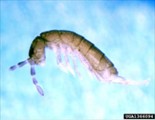Need assistance? Call 800.996.4402

Certain species of springtails are referred to as “snow fleas” when found in winter, but they are not fleas at all. Springtails are found year round, but because of a special protein that acts like anti-freeze, this type of springtail is able to survive in cold winter temperatures. Springtails don’t have wings, instead they get around by jumping, using a unique catapult system. Their jumping is especially noticeable in winter when they are contrasted against white snow.
Springtails are very common around pools with nearby vegetation, around air conditioning condensate drain lines and other moist areas. In winter, snow fleas emerge on sunny days and gather in large numbers around bases of trees where snow has melted. Because of their small size, they look like flecks of pepper or ashes on the surface of the snow. Snow fleas feed on decaying plant matter.
Snow fleas do not cause any structural damage and should not be of concern to homeowners. In addition, snow fleas are not a threat to family pets as they are not a flea at all. Their sole diet consists of rotting plant food.
Snow fleas prefer damp soil, leaf mold, decaying logs and fungi.
If you’re looking to get rid of springtails in the home, reduce sources of excess moisture throughout the house. Leaky pipes and standing water are ideal conditions for springtails when the outside weather becomes too cold. If an indoor infestation becomes too severe, consider hiring a pest professional who specializes in springtail control.
For the very best food safety consulting, auditing and training, please visit our strategic partner, CFS Food Safety